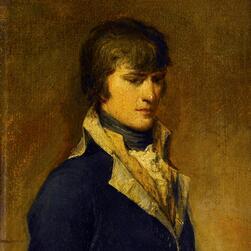In the No. 13 Breakfast Room hangs a truly remarkable portrait: one of the earliest examples of Bonapartism in British cultural history. The small image of the young and rather unrecognisable French general seems inconspicuous in a room bedecked with unusual convex mirrors and many other fine works of art – but when the painting arrived on British soil in 1797, it was the first time any Britons had looked on the face of the future Emperor Napoleon Bonaparte (1769-1821) and it marked the beginning of a long and sometimes inexplicable admiration for one of Britain’s greatest military adversaries.
The casual brushstrokes and diminutive size indicate the harried circumstances in which the portrait was painted – namely, in the young Corsican’s campaign tent on the road from Verona to Vienna in March 1797. An obscure Venetian artist named Francesco Cossia had been commissioned by Maria Cosway (1760-1838), an Anglo-Italian neoclassical artist then living in Oxford Street, to paint likenesses of several inspiring French Revolutionary generals. Cosway was rather a Francophile, hosting salons in London with Whigs, artists, and intellectuals who sympathised with republican ideals, and she famously had a long and lasting relationship with Thomas Jefferson. Although married to the fashionable portrait miniaturist Richard Cosway, in the 1790s she was intimate with the exiled Corsican General Pasquale Paoli, who had been associated with the young Bonaparte in the early years of the French Revolution.
Cosway was able to secure sittings for Cossia to paint this other famous Corsican through a Milanese art dealer and Napoleon’s new bride, Josephine de Beauharnais, and Cossia claimed to be so star-struck by the entire experience that he refused payment for the commission. He was also a little embarrassed about the harried quality of the finished piece, writing in a letter which accompanied the canvas, ‘I did my best, and as much as circumstances would allow of.’ He begged his friend, ‘to excuse me to the lady, and to those who expected more and better from a Venetian painter.’
Cossia had only a few short sittings with the general in which to make a general sketch in pencil directly onto canvas, and he painted in the general’s field dress whilst on his brief three-day ‘campaign’ with the French army. Just before being sent back to Verona, Cossia managed to sit in on one of the general’s manic briefings in order to finish the head. The result is a rather more honest portrait of a field commander than Napoleon’s later stylised portraits by such Parisian Neoclassicists as Gros, David, and Gérard.
Soane himself considered it ‘an exceedingly early and interesting portrait, probably the earliest in existence,’ and made other erroneous assumptions about its provenance. He misread the artist’s signature as ‘Goma’ rather than ‘Cossia’, and was quick to decide that ‘the lady’ (alluded to in Cossia’s letter) who commissioned the portrait was none other than Josephine Bonaparte. The portrait is believed to have entered the Soane’s collection sometime between 1827 and 1830 under unknown circumstances. Soane had organised the auction of Richard Cosway’s effects in 1821, and Maria Cosway’s 1784 work A Persian Lady Worshipping the Rising Sun hangs in the Picture Room.
This singular portrait is almost certainly the first likeness to have been engraved in Britain for general publication and the British press were commenting on it as early as May 1797. Given the exponential increase of Napoleon’s image in British print over the following two decades after this portrait made its appearance in London, and the contested place Napoleon came to hold in the British imagination, this work in Soane’s collection is a treasure indeed.

